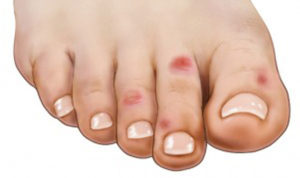CHILBLAINS: WHAT ARE THEY AND HOW CAN YOU AVOID THEM??
Winter brings a whole host of things for us to enjoy… snow, mulled wine and fires to name a few. However, the change in temperature can also cause an increased incidence of some medical conditions. One such condition we see in the clinic is Chilblains.
Chilblains (or erythema pernio) occur primarily during the winter months and rarely cause long-term damage. People susceptible to changes in temperature i.e. the elderly, sedentary people and those with poor circulation, are most at risk of this condition. It is a self-limiting disorder, in that they typically improve as the warmer weather returns, and affect the toes and fingers most commonly. Thankfully, some simple steps can be taken to treat, and then prevent, their occurrence.
PRESENTATION
Common signs and symptoms of Chilblains are:
– Red, blue and/or purple lesions that vary in shape and size;
– Inflamed, swollen skin;
– Itchiness and burning;
– Pain; and,
– Blistering
Less commonly, the area may become ulcerated… this is a serious complication and requires urgent medical care.

CAUSES
Whilst the exact cause isn’t known, it is believed that changes in temperature can lead to dysfunction of the small blood vessels in some individuals. When it is warm, the vessels in our extremities (toes and fingers) dilate to allow the release of heat which regulates our body temperature. When exposed to cold, those vessels constrict and, in ‘at-risk’ people, can lead to a concentration of metabolites/waste products, hypoxia, local tissue damage and the signs/symptoms described above.
Rapid changes in temperature can exacerbate the effects of Chilblains. For example, if the feet are particularly cold/damp and then exposed to heat from a shower, hot pack etc the vessels will rapidly dilate allowing an influx of blood which can cause increased swelling and itchiness. Therefore, it is suggested to warm the affected area slowly and concentrate on increasing the temperature of the whole body, not just the affected area.
TREATMENT
If you are unlucky to have Chilblains the focus of treatment is on symptomatic relief and maintaining the integrity of the skin. This is achieved via:
– The use of a corticosteroid cream to reduce the inflammation/itchiness (if skin is intact);
– The use of Hirudoid cream to help dilate the blood vessels (if skin is intact);
– The use of vasodilator medication if the condition is chronic/severe;
– The use of antibiotics if an infection is present;
– Maintaining regular core body temp through the use of singlets, beanies and appropriate clothing for the current temperature;
– Keeping the feet warm by using woolen socks and slippers and changing socks regularly if they get wet or feel damp; and,
– The avoidance of regular changes in temperature (try to limit going inside and outside too much) as this can confuse the body so it struggles to regulate temperature.

PREVENTION
The saying ‘Prevention is better than cure’ is appropriate for Chilblains as the actual treatment isn’t always effective in speeding up the healing process. When preventing Chilblains, the main thing to achieve is a stable body temperature through the steps outlined above. However, some other things that can help are:
– Regular exercise to improve circulation;
– Reducing or quitting smoking as this constricts blood vessels; and,
– Keeping the ambient environment at a constant temperature
If you think you have Chilblains, or any other foot or ankle condition that needs assessment, book an appointment on 94805522 or via our ‘Book Now’ tab.
By Mark Whiteside
7